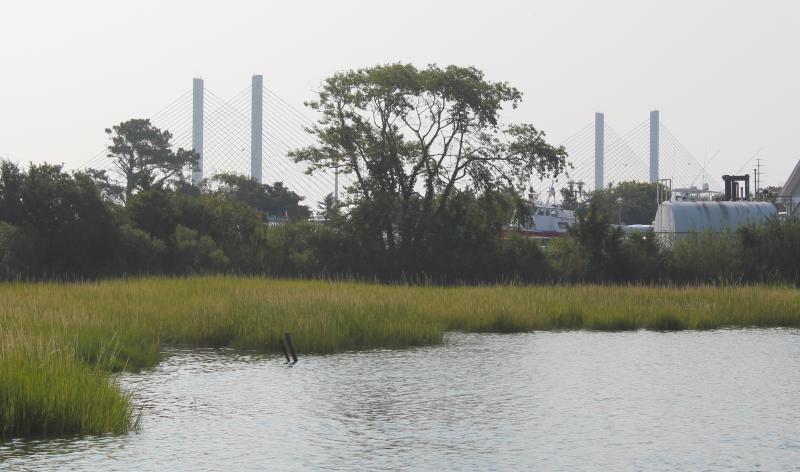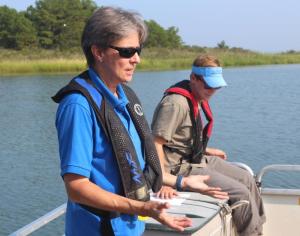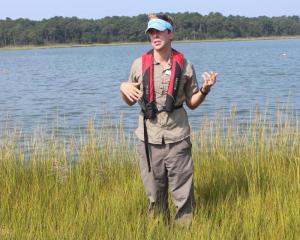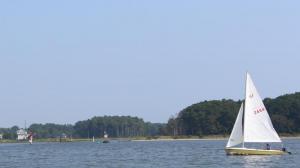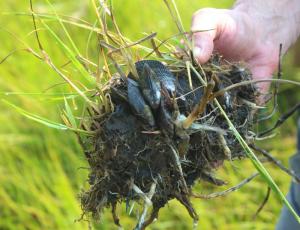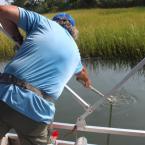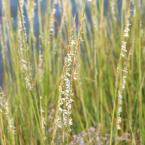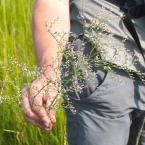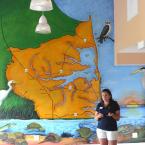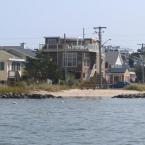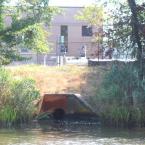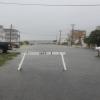Center for the Inland Bays highlights projects
About 45 minutes into a recent boat tour of the Inland Bays, Center for the Inland Bays Executive Director Chris Bason asked program manager and captain for the day Bob Collins to cut the engine.
Floating on a pontoon boat in waist-deep water, Bason pointed to a few dozen laughing gulls on a shoreline beach. The grey ones are this year’s hatchlings, and the white ones are adults, he explained. The marsh islands are a very important breeding ground for laughing gulls, he said.
“That sound is the sound of Delaware beaches,” said Bason of the laughing gull’s cry.
This unplanned educational opportunity was part of a tour hosted by the Center for the Inland Bays, highlighting future and ongoing projects.
Marianne Walch, CIB science and restoration coordinator, said the center is encouraging property owners to get away from hardened approaches to shoring up their waterfront. She pointed to riprap, loose stone piled at the edges of the shoreline, as an example of a once standard practice that is no longer encouraged. It cuts the shoreline off from the surrounding ecological systems, she said.
Walch said the center encourages living shorelines – a combination of cordgrass plantings, oyster bags and wave attenuation devices below the water surface – as best practice. Walch said the living shoreline between the Indian River Marina and the trail that leads out to Burton Island is the oldest living shoreline the center has created and a good example of how one works.
Walch said in areas where bulkheads in place, the center has been installing floating wetlands, large mats planted with grass. She said the plan is to trim them down in the fall and hope they grow back next year.
Up in Herring Creek, Bason said some neighborhoods are beginning to switch from decades-old septic tanks to central sewer. He said this is good for the creek’s well-known fat crabs and other animals living in the creek’s brackish waters because it moves wastewater to a county treatment facility where it can be treated, used in spray irrigation and then filtered by the soil as it slowly makes its way back to the Inland Bays.
At one point, the tour stopped on a saltmarsh island. Bason said these islands can accommodate some level of sea rise because the grasses trap floating debris, which then settles, decays and adds to the island.
“We’re talking millimeters a year,” he said. “The problem is, sea level rise is moving faster than the salt marshes can grow.”
For the overall health of the Inland Bays, Bason said the single, most important change in the past few months is Rehoboth’s shift from dumping its treated wastewater into the Lewes-Rehoboth Canal to the new ocean outfall. He said the change immediately stopped one-third of the total phosphorus load from being dumped into the canal.
Bason said flow in the canal was insufficient to quickly flush treated wastewater, so excess nutrients are not well dispersed in the canal. Out in the ocean, he said, the treated wastewater is flushed rapidly.
Bason said it’s possible the change could lead to opening more shellfishing areas along the shorelines.
For more information on Center for the Inland Bays projects and practices, go to inlandbays.org.











